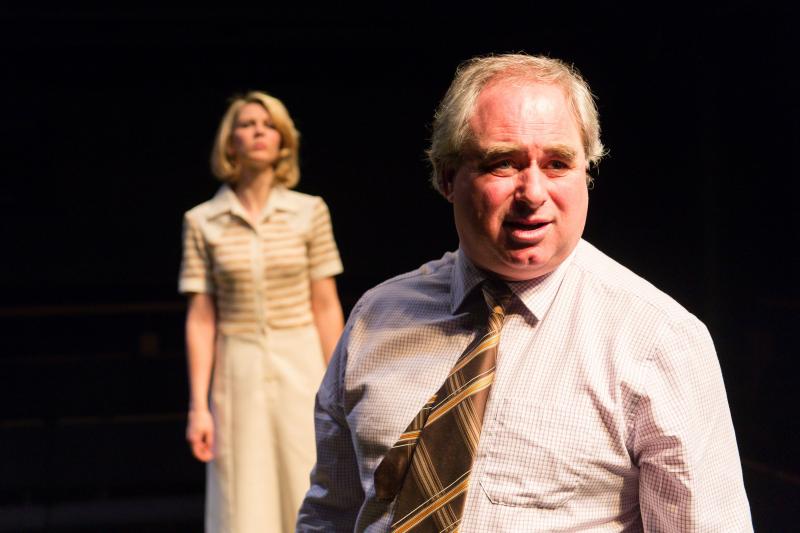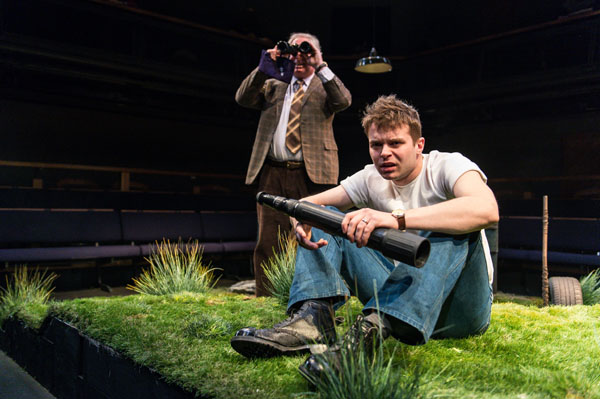German Skerries, Orange Tree Theatre | reviews, news & interviews
German Skerries, Orange Tree Theatre
German Skerries, Orange Tree Theatre
Lovely revival of Robert Holman’s resonant 1977 play about life choices is quietly moving

Birdwatching is not the most thrilling subject for a drama. In fact, next to watching paint dry, it is probably the poorer option. So there is something wonderfully clever and theatrically brilliant about Robert Holman’s 1977 play, which takes place at a popular birdwatching spot overlooking the mouth of the Tees, a location around which several lives meet and connect.
Holman is careful to give Jack a helping hand
The birdwatching spot is an area of rough grassland, beautifully rendered by designer James Perkins, called South Gare, a promontory that juts out into the North Sea. Down below are the German Skerries, a group of partially submerged rocks that got their name during the second world war when a Luftwaffe plane crashed into them. The play revolves around two regular birdwatchers, 59-year-old schoolteacher Martin and 23-year-old Jack, a factory shift-worker, who meet here one summer afternoon. They make a neat contrast, the older man at the end of his career and the younger man at the start of his. Yet they also have something in common: the sense that something is not right with their lives.
As German Skerries seemlessly unfolds, they are joined by two other characters. The first is 34-year-old Michael, who once worked as a pilot for the ships on the River Tees, but now is employed by British Steel to help sort out some pipes that take boiling water from the nearby plant and pump it into the sea. This pollution of nature threatens to disturb the ecological balance, and thus the birdlife of the area, but the construction of these pipes has other, even more dramatic consequences which affect Jack and especially his young wife Carol, who works in the Middlesbrough tax office.
 Holman’s writing is very delicate and subtle, and even the emotional highs of the play barely ripple the surface of the dialogue or muddy the inner lives of the characters. And this story is mainly a study in character, concerned with quiet intensity and deep but undemonstrative passions. The two main male characters both lack confidence and are both full of unrealised potential: the older one knows this, the younger one doesn’t. But if all the people in the play struggle to understand the elusive nature of happiness, this is not a pessimistic or bleak play. Towards the end, Holman is careful to give Jack a helping hand, and to give the audience’s heart a tiny little squeeze. It feels like the most affectionate gesture in the world.
Holman’s writing is very delicate and subtle, and even the emotional highs of the play barely ripple the surface of the dialogue or muddy the inner lives of the characters. And this story is mainly a study in character, concerned with quiet intensity and deep but undemonstrative passions. The two main male characters both lack confidence and are both full of unrealised potential: the older one knows this, the younger one doesn’t. But if all the people in the play struggle to understand the elusive nature of happiness, this is not a pessimistic or bleak play. Towards the end, Holman is careful to give Jack a helping hand, and to give the audience’s heart a tiny little squeeze. It feels like the most affectionate gesture in the world.
Hamilton brings out the piece’s humour, which is as gentle as a mild breeze on a sunny day, and her cast do the play proud. Howard Ward’s Martin conveys the mild bewilderment of a man who feels that he has made a “wrong choice” in his life and who can make a statement such as “Most of us are lazy and afraid” sound like a guru’s aphorism. By contrast, George Evans’s Jack (pictured above with Ward) is all boyish charm and playground jokiness, yet already on the verge of grown-up responsibility, while Katie Moore’s Carol is a mixture of youthful openness and perceptive maturity. With Michael, Henry Everett has a smaller part, which he nevertheless delivers convincingly. This is a loving revival of a lovely play.
rating
Buy
Share this article
The future of Arts Journalism
You can stop theartsdesk.com closing!
We urgently need financing to survive. Our fundraising drive has thus far raised £49,000 but we need to reach £100,000 or we will be forced to close. Please contribute here: https://gofund.me/c3f6033d
And if you can forward this information to anyone who might assist, we’d be grateful.

Subscribe to theartsdesk.com
Thank you for continuing to read our work on theartsdesk.com. For unlimited access to every article in its entirety, including our archive of more than 15,000 pieces, we're asking for £5 per month or £40 per year. We feel it's a very good deal, and hope you do too.
To take a subscription now simply click here.
And if you're looking for that extra gift for a friend or family member, why not treat them to a theartsdesk.com gift subscription?
more Theatre
 The Daughter of Time, Charing Cross Theatre review - unfocused version of novel that cleared Richard III
The writer did impressive research but shouldn't have fleshed out Josephine Tey’s story
The Daughter of Time, Charing Cross Theatre review - unfocused version of novel that cleared Richard III
The writer did impressive research but shouldn't have fleshed out Josephine Tey’s story
 Evita, London Palladium review - even more thrilling the second time round
Andrew Lloyd Webber's best musical gets a brave, biting makeover for the modern age
Evita, London Palladium review - even more thrilling the second time round
Andrew Lloyd Webber's best musical gets a brave, biting makeover for the modern age
 Maiden Voyage, Southwark Playhouse review - new musical runs aground
Pleasant tunes well sung and a good story, but not a good show
Maiden Voyage, Southwark Playhouse review - new musical runs aground
Pleasant tunes well sung and a good story, but not a good show
 The Winter's Tale, RSC, Stratford review - problem play proves problematic
Strong women have the last laugh, but the play's bizarre structure overwhelms everything
The Winter's Tale, RSC, Stratford review - problem play proves problematic
Strong women have the last laugh, but the play's bizarre structure overwhelms everything
 Brixton Calling, Southwark Playhouse review - life-affirming entertainment, both then and now
Nostalgic, but the message is bang up to date
Brixton Calling, Southwark Playhouse review - life-affirming entertainment, both then and now
Nostalgic, but the message is bang up to date
 Inter Alia, National Theatre review - dazzling performance, questionable writing
Suzie Miller’s follow up to her massive hit 'Prima Facie' stars Rosamund Pike
Inter Alia, National Theatre review - dazzling performance, questionable writing
Suzie Miller’s follow up to her massive hit 'Prima Facie' stars Rosamund Pike
 A Moon for the Misbegotten, Almeida Theatre review - Michael Shannon sears the night sky
Rebecca Frecknall shifts American gears to largely satisfying effect
A Moon for the Misbegotten, Almeida Theatre review - Michael Shannon sears the night sky
Rebecca Frecknall shifts American gears to largely satisfying effect
 Burlesque, Savoy Theatre review - exhaustingly vapid
Adaptation of 2010 film is busy, bustling - and bad
Burlesque, Savoy Theatre review - exhaustingly vapid
Adaptation of 2010 film is busy, bustling - and bad
 Don't Rock the Boat, The Mill at Sonning review - all aboard for some old-school comedy mishaps
Great fun, if more 20th century than 21st
Don't Rock the Boat, The Mill at Sonning review - all aboard for some old-school comedy mishaps
Great fun, if more 20th century than 21st
 The Estate, National Theatre review - hugely entertaining, but also unconvincing
Comedy debut stars Adeel Akhtar, but is an awkward mix of the personal and the political
The Estate, National Theatre review - hugely entertaining, but also unconvincing
Comedy debut stars Adeel Akhtar, but is an awkward mix of the personal and the political
 That Bastard, Puccini!, Park Theatre review - inventive comic staging of the battle of the Bohèmes
James Inverne enjoyably reconstructs the rivalry between Puccini and Leoncavallo
That Bastard, Puccini!, Park Theatre review - inventive comic staging of the battle of the Bohèmes
James Inverne enjoyably reconstructs the rivalry between Puccini and Leoncavallo

Add comment